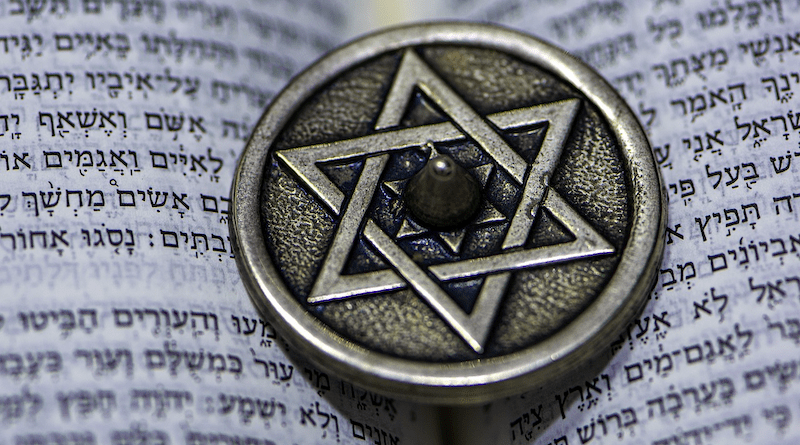An EREV RAV: Conversion Then And Now – OpEd
Judaism is not a missionary faith and so doesn’t actively try to convert non-Jewish people (in many countries anti-Jewish laws prohibited converting to Judaism for centuries). Despite this, the modern Jewish community does increasingly welcome would-be converts. A person who converts to Judaism becomes a Jew just as Jewish, or often more so, than someone born into Judaism.
There is a good precedent for this. Ruth, the great-great grandmother of King David, was a convert to Judaism, and the book of Ruth in the Bible which tells the story of her becoming Jewish, is read every year during the services held on Shavuot; the celebration of the Jewish People’s receiving the Torah at Mount Sinai.
Although Jews do not send out missionaries, it is a Mitzvah for Jews to welcome non-Jews who are interested to study Judaism and to join the Jewish people if they so desire.
When the Jewish People escaped from Egypt the Torah tells us (Exodus 12:38) that an erev rav, a mixed multitude of other people, also escaped with them. Who were these people; and why does it matter today? I offer five answers to be shared at your Seder.
A- The erev rav mixed multitude were the Egyptian relatives of Shifra and Puah, the Egyptian midwives who refused to follow Pharaoh’s orders to kill all the new born baby boys they delivered. (Exodus 1:17-19) Shifra, Puah, all their direct descendants and almost all the families their descendants had married into; all joined Israel in the Exodus, at Sinai, and a generation later entered with Israel into the Land of Israel.
B- The erev rav mixed multitude were the descendants of Midianites who had by 3300 BCE also been enslaved by the Egyptians and forced to mine the great copper, gold and turquoise deposits of Serabit el-Khadem in the Sinai peninsula.
Their descendants who now lived in the Goshen delta knew that Moses had married Tsiporah, the daughter of Jethro, a Midianite priest, who had stopped worshipping idols due to the influence of Moses. Hathor, the cow goddess, had been their protector at Serabit el-Khadem, which was not far from Sinai; and a few of these minor’s descendants were the ones who suggested making the golden calf when the Jewish people feared Moses had died on Mount Sinai.
C- The erev rav mixed multitude were descendants of the hundreds of followers of Pharaoh Akhenaten and his wife Nefertiti, who worshiped At-en, the Solar Disc, as their one God, although for political reasons, Pharaoh wanted all the rest of the Egyptian people to continue worshiping Pharaoh as the Divine Son of God. Almost all of them joined Israel in the Exodus, at Sinai, and a generation later entered with Israel into the Land of Israel.
D- The erev rav mixed multitude were descendants of the family of Asenath, a daughter of Potiphera, a priest from the city of On (LXX: Heliopolis), who Pharaoh gave to Joseph to be his wife (Genesis 41:45). Some of these descendants influenced Thutmose III (sometimes read as Thutmosis) and his son Akhenaten toward monotheism. They, like Bnai Israel, were also enslaved when the 18th dynasty was replaced by the 19th dynasty of Ramose I, the Pharaoh who did not want to know Joseph. (Exodus 1:8)
E- The erev rav mixed multitude were the large numbers of individuals from several Egyptian clans and various oppressed ethnic groups, including all the above, who wanted to join the people of Israel and share its destiny because they were favorably impressed by Moses (Exodus 3:21 and 11:3) and who were rescued from the 10th plague because they lent silver and copper vessels to their Jewish neighbors. (Exodus 3:22, 11:2 and 12:35-36). Lent to them not despoiled, because the primary meaning of the Hebrew word nitsal in all three verses is rescue, only the secondary meaning is plunder.
Not all of the erev rav mixed multitude who joined the Jewish people turned out to be better than average Jews; but most of them and their descendants did become better than average Jews. This was true in the past, is ue now, and will be true also in our future.
That is why the Talmud (Sanhedrin 99b) condemns those who push potential converts away by relating that Isaac and Jacob pushed away Timna the sister of Lotan who wanted to become Jewish. She then married a son of Esau. One of her descendants was Amalek who attacked Israel shortly after they escaped from Egypt. If, instead of being pushed away, Timna had become Jewish, Amalek would have been on our side, and not one of our enemies. A more practical view is hard to imagine.
Indeed, several Talmudic Rabbis felt that discouraging converts in the past had brought troubles upon the Jewish People. Rabbi Johanan says the Jews were oppressed and enslaved in Egypt because Abraham didn’t try to influence some captives that he rescued to become Jewish. Even failing to encourage potential converts is wrong according to Rabbi Johanan.
Every rabbi who deals with converts and conversion should be guided by the general principle of Jeremiah’s description of the God of Israel:”Behold, I am a God who brings near’ says the Lord, “and not a God who pushes away”. (Jeremiah 23:23)
Although tradition says we should not mention who is a convert, this was only due to the danger of conversion to Judaism in the Dark Ages, and nowadays to tell those Jews who think birth is more important than commitment to keep their mouth shut.
Why not share stories of converts to Judaism at our Seder when we get to the fourth child who did not feel anything about Judaism until starting on the path to becoming Jewish.

